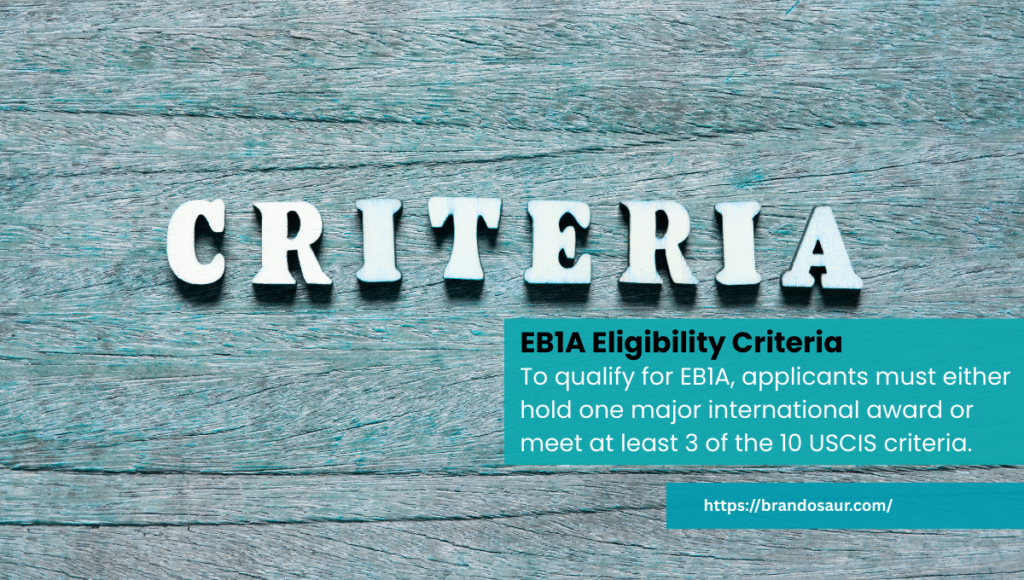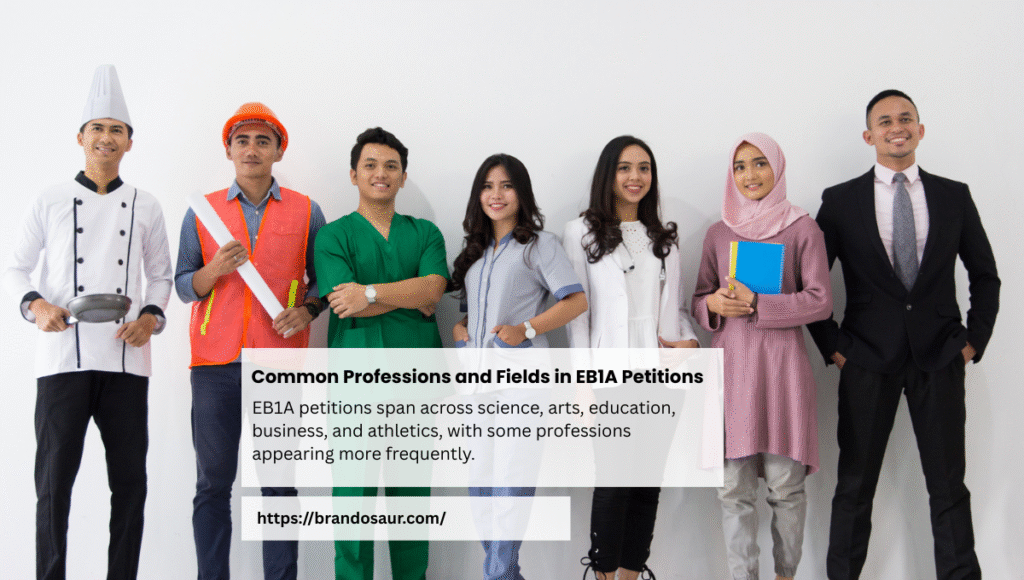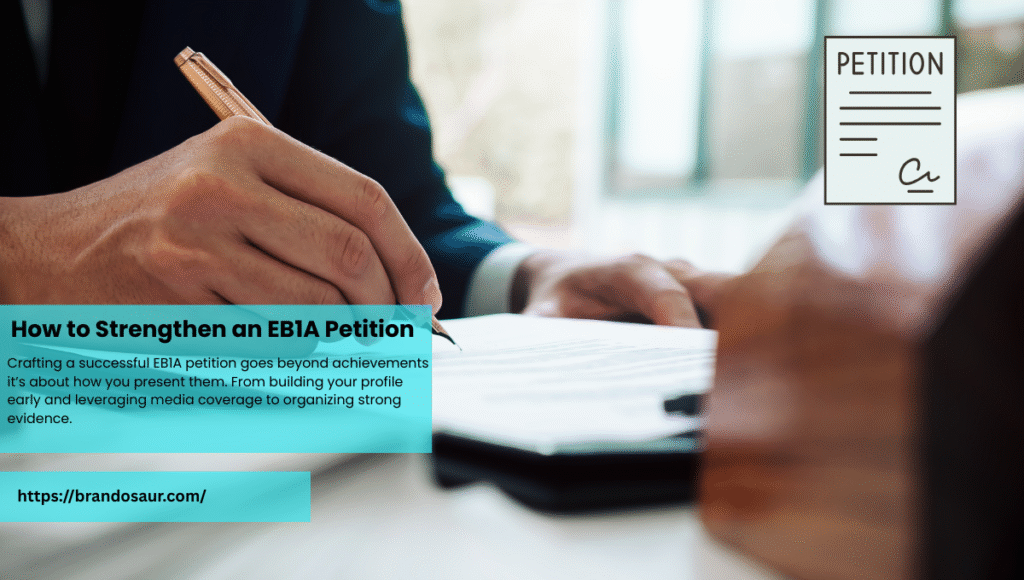The EB1A Visa (Employment-Based First Preference, Alien of Extraordinary Ability) is a fast-track U.S. green card for individuals “at the very top of their field.” It is reserved for people with sustained national or international acclaim in science, arts, education, business, or athletics. Importantly, EB1A applicants can self-petition without an employer sponsor or labor certification.
This makes it ideal for global talent, entrepreneurs, scientists, researchers, engineers, artists, attorneys, and others who have distinguished achievements in their profession. In this guide, we explain the EB1A eligibility criteria and highlight the common professions and evidence types in successful EB1A cases.
What is the EB1A Visa?
The EB1A visa grants immediate U.S. permanent residency (a green card) to individuals of extraordinary ability. Key features include:
1) Extraordinary Ability Requirement
You must show sustained acclaim and recognition in your field. For example, USCIS lists fields like science, business, arts, technology, education, and sports as eligible.
2) No Job Offer Needed
EB1A is unique among green cards because you self-petition. There is no requirement for a U.S. employer to sponsor you or obtain a labor certification. This allows entrepreneurs and freelancers to apply on their own behalf.
3) One-Time Achievement or Multiple Criteria
You must either have a one-time major international award (e.g., Nobel Prize, Olympic medal) or meet at least three of the ten USCIS criteria. These criteria range from prizes and publications to leadership roles and high compensation.
4) Continued Work in the Field
You must intend to continue working in your field of extraordinary ability once in the U.S. A letter from a potential employer or a personal business plan can document this.
According to a visa attorney site, the EB1A visa is an excellent choice for individuals who possess exceptional skills in the fields of science, business, arts, technology, education, sports, or similar areas.
In practice, EB1A applicants must carefully document their high-level achievements. One planning tip is to build a strong portfolio well before applying, for example, by publishing papers, winning awards, or gaining media coverage. (See Brandosaur’s [guide on building an EB1A profile] and [public relations strategies] for more on this.)

EB1A Eligibility Criteria
To qualify under EB1A, USCIS requires either a single outstanding award or meeting 3 out of 10 criteria. The 10 criteria (with examples) include:
- National/International Awards: Receiving a recognized prize or award for excellence (besides Nobel/Oscar).
- Memberships: Membership in organizations that demand outstanding achievement (e.g., IEEE Senior Member, Pulitzer committee).
- Published Material: Articles or press coverage about you or your work in professional journals or major media.
- Judging Others: Serving as a judge or reviewer of the work of peers (e.g., journal referee, award judge).
- Original Contributions: Documented significant contributions to the field (e.g., patented inventions, innovative research results).
- Scholarly Publications: Authorship of academic papers or books in reputed journals or media.
- Exhibitions or Performances: Display or performance of your work (art, design, performances) at major events.
- Leading Roles: Leading or critical roles in distinguished organizations (e.g., department head, company CTO).
- High Salary: Evidence that you earn significantly more than most peers in your field.
- Commercial Success: Notable box office, sales records, or other success in performing arts or entertainment.
Tip: Many successful applicants submit evidence for more than three categories to make their case compelling. For instance, a scientist might combine major grants, publications, citations, and awards to strengthen the petition.
Every piece of evidence should be documented (award certificates, media clippings, letters, etc.) and tied to the criteria. If the standard criteria don’t fit a profession exactly, USCIS will accept comparable evidence. But the overall portfolio must convincingly show “one of the small percentage who have risen to the very top” in the field.

Common Professions and Fields in EB1A Petitions
EB1A applicants come from a broad range of professions, but some fields appear most frequently. The USCIS guidance itself lists science, arts, education, business, and athletics, and practitioners report these common occupations:
1) Researchers & Scientists
This includes natural scientists, biomedical researchers, PhD scholars, and R&D engineers. These applicants typically have numerous peer-reviewed publications, patents, or major conference presentations. For example, “a researcher with breakthroughs published in Nature or Science” is a classic EB1A profile. Key evidence: high-impact articles, citation indices, major grants, or leading research projects. Scholarly work is crucial – as one analysis notes, published research is “one of the strongest indicators of extraordinary ability” for academics.
2) Engineers & Tech Innovators
This overlaps with scientists but focuses on applied technology. Senior engineers, software architects, and tech startup founders fall here. Their accomplishments might include widely-used software, industry awards (e.g., ACM prizes), or leadership of influential projects. Brandosaur’s [EB1A guide for Software Engineers] emphasizes demonstrating “exceptional technical impact and recognition” in the tech world. Common evidence: patents, open-source contributions, press features on innovations, or leadership roles (e.g., CTO of a fast-growing company).
3) Entrepreneurs & Business Leaders
Founders and executives in business or finance are prominent EB1A applicants. For example, “a business leader who founded a globally recognized company” often meets EB1A criteria with a combination of leadership and innovation. Evidence may include successful funding rounds, media coverage of a startup, industry awards, or metrics showing company growth. Boundless notes that for business talents, proving a critical role in an organization’s success is very compelling. This could mean annual reports linking your work to growth or testimonials from board members. National or international business awards also count.
4) Artists & Creative Professionals
Visual artists, musicians, filmmakers, actors, writers, and other creatives with international acclaim often pursue EB1A. The AB Legal Consult guide specifically cites “artists, designers, and filmmakers” as typical applicants. For creatives, relevant evidence includes major exhibition catalogs, reviews in leading art journals, record sales/charts, or festival awards. For example, a professional artist with exhibitions at major galleries or a filmmaker with prizes at international festivals illustrates extraordinary ability. Even performing artists can use commercial success (ticket sales, box office) as evidence.
5) Academics & Educators
University professors, academic researchers, and scholars in education. They often qualify through a combination of publications, citations, teaching awards, and professional recognition (like a fellowship in an academic society). USCIS explicitly lists “education” as a field for EB1A. Evidence can mirror that of researchers: leading research publications, textbooks, invited lectures, or keynote speaking roles. Winning academic awards (e.g., outstanding professor awards) also helps. Some of these candidates might also use the Outstanding Professors/Researchers (EB1B) category, but EB1A is an option if they have individual acclaim without needing a job offer.
6) Legal Professionals (Attorneys)
Top attorneys or legal scholars are less common EB1A applicants, but some lawyers with extraordinary records have succeeded. For example, an international human-rights lawyer who has won major global awards or who publishes widely-read legal commentary might qualify under the “education” or “business” fields by analogy. In practice, however, many attorneys find the EB-2 (NIW) or O-1 visa routes more suited to legal careers. If an attorney does apply for EB1A, evidence might include landmark case victories, leadership in bar associations, or influential publications. (US law firms generally recommend EB-2 NIW for most legal professionals unless they truly have global acclaim.)
7) Athletes & Sports Figures
Elite athletes and sports coaches can use EB1A by virtue of international awards or records (e.g., Olympic/World Championship medals). The USCIS fields include athletics, so an Olympic medalist or a world-record holder easily meets the “major one-time achievement” criterion. Sports figures with national titles or world rankings can also compile evidence (press, endorsements, judging at sports events) to qualify.
These categories are not exhaustive, but they reflect the global talent sectors most frequently seen in EB1A filings. One practitioner notes that research and science are especially common, but tech entrepreneurs, business executives, Olympic athletes, and award-winning creatives also feature often. In each field, the key is concrete evidence of being among the very top, for example, patents and publications for scientists, successful startups or leadership awards for entrepreneurs, and national/international honors for artists and athletes.

Below is a comparison of the EB-1A visa with some alternative visa categories that top professionals often consider:
| Visa Type | Description | Employer Sponsor Required? | Outcome/Duration |
| EB-1A (Extraordinary Ability) | Immigrant visa (Green Card) for top professionals. No job offer needed. | No (self-petition allowed) | Permanent LPR (Green Card) |
| O-1 (Extraordinary Ability, nonimmigrant) | Temporary work visa for aliens with extraordinary ability. Must be sponsored by a U.S. employer or agent. | Yes (U.S. petitioning employer/agent) | Up to 3 years initially (renewable) |
| EB-2 NIW (National Interest Waiver) | Immigrant visa for exceptional ability or advanced degree holders benefiting the U.S. Must serve U.S. interests. | No (self-petition allowed) | Permanent LPR (Green Card), slightly lower standard than EB1A |
This table summarizes that EB-1A is the only permanent green card for extraordinary ability, with no sponsor required. In contrast, the O-1 is temporary and needs sponsorship, while the EB-2 NIW is also a green card but has a more lenient “exceptional ability” standard and requires demonstrating national interest. EB-1A cases typically process faster since visa numbers are always current for EB-1.
How to Strengthen an EB1A Petition
Regardless of profession, packaging your EB1A petition well is crucial. Here are some best practices:
1) Build Your Profile Early
Cultivate achievements and documentation well before filing. Publications, patents, awards, and media mentions can take years to accumulate. For example, seek high-profile speaking engagements or collaborations that may generate press coverage.
2) Leverage Media & PR
Published materials about you strengthen two criteria. Pursue articles, interviews, or even white papers in respected outlets. Brandosaur advises that proactive PR (press releases, thought leadership) can directly provide evidence.
3) Gather Strong Recommendation Letters
Expert reference letters are critical. Use renowned figures in your field (unbiased by close personal ties) who can clearly describe your impact. They should explicitly link your accomplishments to USCIS’s criteria.
4) Be Organized and Precise
Present evidence with indices, tables, and explanations. As one guide notes, an organized petition letter that maps each document to the EB1A criteria makes a big difference. Avoid filler; every item should have a clear purpose. For example, include a chart of your publications and citations or a tabulated list of awards by date.
5) Avoid Common Pitfalls
Don’t assume USCIS understands the significance of your work. Spell out why each achievement is extraordinary. Avoid weak evidence (like generic testimonials without specifics). Ensure all foreign documents are translated, and avoid overloading the dossier with repetitive material.
Remember, the EB-1A standard is very high. As Brandosaur’s analyses note, only candidates who are truly “among the small percentage at the very top of [their] field” succeed. According to data, well-prepared EB-1A petitions (especially with counsel) often achieve approval rates far above general green-card averages.
If you have extraordinary achievements and aim for U.S. permanent residency, don’t leave your EB1A petition to chance. At Brandosaur, we specialize in guiding global talent through the EB-1A process. Our experts can evaluate your profile, suggest evidence strategies, and even boost your visibility through media outreach. Whether you’re a researcher, entrepreneur, engineer, or artist, we can help you tell your story in the best light. Book a free consultation today to discuss your qualifications and next steps toward the EB1A green card.
This guide is based on USCIS policy and industry sources. If your field is not listed above, remember that any profession can apply for EB1A if you meet the criteria. The focus should be on documenting how you stand out globally in your profession.

FAQ
What professions commonly qualify for EB1A?
EB1A applicants typically include research scientists, engineers, tech entrepreneurs, business executives, artists/performers, academics, and top athletes. For example, researchers with breakthroughs, startup founders with global impact, university professors with famous publications, award-winning artists, and Olympic athletes are often seen. (Almost any field can apply if you have top-tier achievements.) Immigration experts note that scientists and tech professionals are frequent applicants, but so are creative professionals and business leaders.
What evidence is needed to prove “extraordinary ability”?
You must document your achievements through concrete evidence. USCIS requires either evidence of a major award or at least three of the 10 criteria listed above. For instance, published articles about you, official awards, high salary records, patent filings, or peer-reviewed papers are common evidence. It’s critical that each piece (articles, certificates, letters) is verifiable and clearly meets a criterion. As a best practice, applicants often provide evidence for more than three categories to build a strong case.
Do I need a U.S. employer or job offer for EB1A?
No. Unlike many work visas, EB1A does not require a job offer. You file the petition yourself (self-petition) and must simply show you intend to continue in your field. For example, you could submit a personal statement or a letter from a potential employer/client about your intended work. This freedom makes EB1A attractive to entrepreneurs and freelancers.
How does EB1A differ from an O-1 visa or EB-2 NIW?
EB1A is a green card (immigrant visa) granting permanent residency, while O-1 is a temporary work visa. EB1A requires extraordinary ability but no sponsor, whereas O-1 requires an employer or agent petition. The EB-2 National Interest Waiver (NIW) is another self-petition green card, but with a lower “exceptional ability” standard and an emphasis on U.S. national benefit.
Can entrepreneurs and startup founders apply for EB1A?
Yes, the founders of innovative companies can qualify if they are among the top entrepreneurs. Evidence might include successful funding (e.g., major VC backing), industry awards (startup pitch competitions), patents, press coverage, or trade show awards. Showing you played a “critical role” in a company’s success (with letters from co-founders, metrics of growth, etc.) is often key. For tailored advice, see Brandosaur’s [EB1A for Software Engineers] guide, which applies similar principles to tech entrepreneurs.
Can artists and musicians qualify for EB1A?
Definitely. EB1A covers “arts” and “athletics.” Internationally recognized artists and performers can apply. Evidence for creatives includes awards (e.g., film festivals, art competitions), exhibitions (gallery shows, film releases), media reviews, and commercial success (ticket sales, chart rankings). For example, an award-winning filmmaker or a bestselling author can meet EB1A criteria through their prizes and publications.
What are some common mistakes to avoid?
A frequent error is submitting weak or irrelevant evidence. Make sure each document aligns with an EB1A criterion and clearly shows your exceptional status. Generic letters or minor awards won’t suffice. Also, avoid vague claims; provide context (e.g., explain the prestige of an award). Lastly, ensure all materials are organized and translated (if needed). As Brandosaur notes, clear indexing and a narrative petition letter are crucial for an officer’s review.



